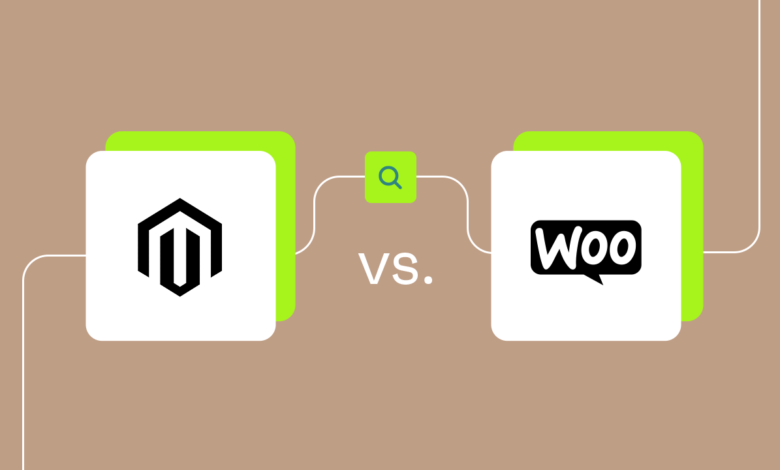Magento vs. WooCommerce: 2023 Comparison
Deprecated: preg_split(): Passing null to parameter #3 ($limit) of type int is deprecated in /home4/ldahphmy/public_html/techbestspot/wp-content/themes/jannah/framework/functions/post-functions.php on line 791

When it comes to establishing an online business, choosing the right e-commerce platform can significantly impact its success. In today’s competitive digital landscape, two prominent players stand out: Magento and WooCommerce.
Magento website development became a popular option because of Magento’s robustness and scalability. It offers a comprehensive set of features designed to meet the needs of businesses of all sizes. With both open-source and enterprise editions, Magento provides advanced capabilities such as extensive customization, multi-store functionality, and powerful SEO tools. It is a preferred choice for large-scale enterprises with complex requirements and sizable inventories.
On the other hand, WooCommerce is a plugin specifically designed for WordPress websites, seamlessly integrating e-commerce functionality into the popular content management system. Known for its user-friendliness and simplicity, WooCommerce offers essential features for product management, flexible payment and shipping options, and a wide range of plugins and extensions. It has gained popularity among small to medium-sized businesses seeking an accessible e-commerce solution within the WordPress ecosystem.
Magento vs. WooCommerce: Key Features Comparison
In this section, we will compare the key features of Magento and WooCommerce, two leading e-commerce platforms. By examining their capabilities in areas such as product management, payment and shipping options, multi-store functionality, SEO tools, customization, and the availability of plugins and extensions, you can determine which platform aligns better with your business needs.
Magento Key Features
- Advanced product management capabilities
Magento provides robust tools for managing products, making it ideal for businesses with large inventories and complex product structures. It supports attributes, categories, product bundles, and configurable products. The advanced product management capabilities allow for efficient organization and control over product listings.
- Multiple payment and shipping options
Magento offers a wide range of payment gateways and shipping options, providing flexibility for businesses and customers. With integration options for popular payment processors and compatibility with various shipping carriers, Magento enables you to offer diverse payment and shipping choices to your customers.
- Multi-store functionality
One of Magento’s strengths is its ability to manage multiple online stores from a single backend. This feature is particularly beneficial for businesses that operate multiple brands or target different markets. With Magento, you can efficiently manage inventory, orders, and customer data across multiple stores.
- Powerful SEO tools
Magento includes built-in SEO features to help improve your store’s search engine rankings. It offers customizable URLs, meta tags, and XML sitemaps. You can optimize product pages, category pages, and other elements to enhance visibility and attract organic traffic to your online store.
- Extensive customization capabilities
Magento is highly customizable, allowing you to create unique and personalized customer experiences. It provides flexibility for design and functionality through custom themes, layouts, and extensions. With Magento, you can tailor your store’s appearance and features to align with your brand and specific business requirements.
WooCommerce Key Features
- Easy product management
WooCommerce simplifies product management, making it accessible to users of varying technical abilities. You can easily add, edit, and categorize products, set attributes, and variations through its user-friendly interface. WooCommerce’s integration with WordPress enhances the overall simplicity of managing your online store.
- Various payment and shipping options
WooCommerce supports multiple payment gateways and shipping methods, offering flexibility for businesses and customers. It integrates with popular payment processors like PayPal and Stripe and provides options for local pickup, flat rate, or real-time shipping calculations. You can tailor payment and shipping methods to suit your target market.
- Basic SEO tools
While not as extensive as Magento, WooCommerce provides basic SEO tools to optimize your store for search engines. You can set meta tags, URLs, and manage permalinks to enhance your store’s visibility. Additionally, utilizing popular SEO plugins available for WordPress can further improve your SEO performance.
- Wide range of plugins and extensions
WooCommerce benefits from being part of the extensive WordPress ecosystem. You have access to a vast collection of plugins and extensions, allowing you to extend the functionality of your online store. Whether it’s adding additional payment gateways, integrating marketing tools, or enhancing product display options, WooCommerce’s plugin ecosystem offers flexibility and customization possibilities.
Magento and WooCommerce differ in their key features, catering to different business requirements and user preferences. Assess your specific business needs and prioritize the key features that align with your goals to make an informed decision on the best e-commerce platform for your online store.
Magento vs. WooCommerce: Performance and Scalability Comparison
Performance and scalability are critical factors to consider when selecting an e-commerce platform. In this article chapter, we will delve into the performance and scalability aspects of Magento and WooCommerce. We will explore how these platforms cater to different business sizes and handle increasing demands, helping you make an informed decision based on your specific requirements.
Magento Performance and Scalability Options
Magento is renowned for its ability to handle the complex needs of large-scale businesses. With its robust architecture, Magento offers high performance and stability even with a large inventory and high website traffic. Its advanced caching mechanisms and optimized database structure contribute to faster page loading times, ensuring a seamless shopping experience for customers.
Magento provides scalability options to accommodate the growth of your business. It supports horizontal scalability, allowing you to distribute the load across multiple servers to handle increasing traffic and transactions. Additionally, Magento offers cloud-based hosting solutions and works well with Content Delivery Networks (CDNs) to enhance performance and scalability.
WooCommerce Performance and Scalability Options
WooCommerce is designed to cater to small to medium-sized businesses. It performs well under moderate traffic and product volumes typically associated with these business sizes. WooCommerce leverages the infrastructure of WordPress, which has been optimized for performance, resulting in fast page loading times and smooth user experience.
While WooCommerce is suitable for smaller businesses, it may have limitations when it comes to handling substantial growth or high levels of website traffic. As your business expands, you may need to implement optimization techniques such as caching, database optimization, and upgrading hosting resources to maintain optimal performance. WooCommerce can scale to a certain extent, but it may require additional measures to handle significant growth effectively.
Magento and WooCommerce differ in terms of performance and scalability, catering to different business sizes and requirements. Magento excels in performance for large-scale businesses, providing stability, fast page loading times, and robust infrastructure. It offers extensive scalability options to accommodate increasing traffic and transactions. On the other hand, WooCommerce performs well for small to medium-sized businesses, leveraging the optimized infrastructure of WordPress. While WooCommerce can scale to a certain extent, it may require additional optimization measures as your business grows significantly.
Consider your current business size, projected growth, and expected website traffic when evaluating the performance and scalability aspects. It’s essential to choose a platform that can meet your present needs and provide room for future expansion without compromising on performance and user experience.
Magento vs. WooCommerce: Flexibility and Customization Comparison
In this article chapter, we will delve into the extent to which Magento and WooCommerce allow businesses to tailor their online stores according to their specific requirements, helping you make an informed decision based on your business’s unique needs.
Magento Flexibility and Customization Possibilities
Magento offers a high level of flexibility and customization options, making it a preferred choice for businesses with complex requirements. With Magento, you have granular control over your online store’s design, functionality, and user experience. You can create custom themes, layouts, and templates, enabling you to create a unique brand identity. Additionally, Magento’s modular architecture allows for seamless integration of extensions and custom-built functionalities, expanding the platform’s capabilities to meet specific business needs.
Magento is built to handle complex business requirements, making it suitable for enterprises with intricate product structures, pricing models, and multi-store operations. It offers advanced features such as configurable products, product bundles, and custom pricing options. Furthermore, Magento’s robust architecture supports the creation of multiple websites, stores, and store views, allowing businesses to manage diverse product catalogs and target different customer segments effectively.
WooCommerce Flexibility and Customization Possibilities
WooCommerce provides businesses with a considerable degree of flexibility and customization. As an extension of WordPress, WooCommerce benefits from the vast collection of WordPress themes and plugins. You can choose from numerous pre-designed themes or develop a custom theme that aligns with your brand identity. WooCommerce’s plugin ecosystem offers a wide range of extensions that enhance functionality, such as advanced product display options, payment gateways, and marketing tools. This flexibility allows businesses to tailor their online stores to suit their unique needs.
WooCommerce seamlessly integrates with the WordPress ecosystem, leveraging the extensive WordPress community and resources. This compatibility provides businesses with access to a wide range of WordPress themes and plugins, offering additional flexibility and customization options. As WordPress is a popular content management system, it enables businesses to manage their e-commerce store and content from a unified interface, simplifying the overall management process.
Magento and WooCommerce differ in terms of flexibility and customization capabilities, catering to different business requirements. Magento offers a high level of flexibility and customization potential, allowing businesses to create unique and tailored online stores. It excels in handling complex requirements, making it suitable for enterprises with intricate product structures and multi-store operations. On the other hand, WooCommerce provides businesses with a considerable degree of flexibility through its compatibility with the WordPress ecosystem. Leveraging the extensive collection of themes and plugins, businesses can customize their stores to suit their specific needs.
Consider the complexity of your business requirements and the level of customization you desire when evaluating the flexibility and customization aspects. Determine the level of control you need over your online store’s design and functionality, as well as the availability of themes and plugins that align with your brand vision. By carefully assessing these factors, you can choose the platform that best suits your business’s unique needs for flexibility and customization.
Magento vs. WooCommerce: User-Friendliness Comparison
Understanding the user-friendliness of Magento and WooCommerce will help you make an informed decision based on your team’s skill set and your preference for an intuitive and hassle-free e-commerce experience. We will assess their learning curves, ease of use, and suitability for both technical and non-technical users below.
User-Friendliness of Magento
Magento has a steeper learning curve compared to other e-commerce platforms. Its robustness and extensive feature set come with a higher level of complexity. Magento requires some level of technical expertise to set up, configure, and manage the platform effectively. Users with technical backgrounds or experience with e-commerce platforms may find it easier to navigate Magento’s interface and utilize its features.
Non-technical users may face challenges when working with Magento. The platform’s advanced customization options and complex configurations can be overwhelming for users without technical knowledge. However, with the assistance of Magento’s documentation, community forums, and support resources, non-technical users can still navigate and utilize Magento’s features with proper guidance and learning.
User-Friendliness of WooCommerce
WooCommerce is known for its user-friendly interface and ease of setup. It is designed to cater to users of varying technical abilities. With its intuitive and straightforward user interface, WooCommerce simplifies the process of managing products, inventory, and orders. The platform provides a seamless onboarding experience, making it accessible even for users with limited technical knowledge.
One significant advantage of WooCommerce is its integration with the WordPress ecosystem. If you are familiar with WordPress, you will find WooCommerce’s interface and functionalities to be familiar and easy to navigate. Since WooCommerce is built as a WordPress plugin, it inherits the user-friendly and intuitive nature of WordPress, making it a popular choice for WordPress users looking to add e-commerce capabilities to their existing websites.
In conclusion, Magento, while powerful and feature-rich, has a steeper learning curve and may require technical expertise for efficient use. Non-technical users may face challenges initially, but with adequate learning resources, they can still navigate and utilize Magento effectively. On the other hand, WooCommerce excels in user-friendliness with its intuitive interface and ease of setup. Its integration with the WordPress ecosystem makes it especially appealing to WordPress users. Consider the technical expertise of your team and your comfort level with managing an e-commerce platform when evaluating the user-friendliness aspect.
Magento vs. WooCommerce: Pricing and Support Comparison
Pricing and support are crucial factors to consider when choosing an e-commerce platform. In this article chapter, we will compare the pricing structures and available support options for Magento and WooCommerce. Understanding the costs associated with each platform and the level of support provided will help you make an informed decision based on your budget and the level of assistance you require for your online store.
Magento Pricing and Support
Magento offers two editions: the open-source (Community) edition and the enterprise (Commerce) edition. The open-source edition is free to use, making it an attractive choice for businesses with budget constraints. However, it requires technical expertise to set up and maintain. The enterprise edition, on the other hand, is a paid version with additional features and support. The pricing for the enterprise edition varies based on the size and requirements of your business.
Magento provides various support options for users. The open-source edition offers community support through forums, user groups, and extensive documentation. The enterprise edition comes with dedicated support and service level agreements (SLAs) provided by Magento’s customer support team. Additionally, Magento offers training resources, webinars, and developer certification programs to assist users in utilizing the platform effectively.
WooCommerce Pricing and Support
WooCommerce itself is free to use as it is a plugin for WordPress, which is an open-source platform. However, there are associated costs to consider. You will need web hosting, a domain name, and potentially premium themes or extensions, which may incur costs depending on your requirements. The overall expenses of running a WooCommerce store depend on the specific choices you make in terms of hosting, themes, and plugins.
WooCommerce benefits from the extensive WordPress community and support resources. Users can access community forums, documentation, and tutorials to find answers to their questions and troubleshoot issues. Additionally, there are dedicated WooCommerce support teams, premium support options, and third-party experts who can provide assistance, training, and customization services if needed.
Magento and WooCommerce differ in terms of pricing structure and available support options. Magento offers both free and paid editions, providing flexibility for businesses of different sizes and budgets. It offers community support for the open-source edition and dedicated support for the enterprise edition. WooCommerce, as a free plugin for WordPress, provides cost-effective options, with associated costs related to hosting and optional premium themes and extensions. It benefits from the extensive WordPress community and resources, offering a range of support channels and community-driven assistance.
Final Thoughts
When choosing an e-commerce platform for your business, it’s essential to consider individual requirements and preferences. In this article, we compared Magento and WooCommerce in terms of key features, performance and scalability, flexibility and customization, user-friendliness, pricing and support.
Magento offers advanced product management capabilities, multiple payment and shipping options, multi-store functionality, powerful SEO tools, and extensive customization capabilities. It is a robust platform designed for large-scale businesses with complex requirements. Magento excels in performance, scalability, and handling intricate product structures. However, it has a steeper learning curve and may require technical expertise to fully utilize its capabilities.
On the other hand, WooCommerce provides easy product management, various payment and shipping options, basic SEO tools, and a wide range of plugins and extensions. It is a user-friendly platform that integrates seamlessly with WordPress, making it an ideal choice for small to medium-sized businesses. WooCommerce offers flexibility and customization options through the vast WordPress ecosystem, although its scalability may require additional optimization measures as business grows significantly.
The final verdict on the suitability of Magento vs. WooCommerce in 2023 depends on your business requirements and preferences.
Choose Magento if you:
- Have a large-scale business with complex product structures and pricing models.
- Require advanced customization options and extensive control over your online store.
- Can allocate resources for technical expertise and have the capacity to manage a more complex platform.
Choose WooCommerce if you:
- Operate a small to medium-sized business with simpler product structures.
- Prefer a user-friendly platform with easy setup and management.
- Value the extensive WordPress ecosystem, including themes, plugins, and a familiar interface.
Ultimately, the decision should align with your specific business goals, budget, technical capabilities, and growth plans. Carefully assess the key factors discussed in this article to make an informed choice that empowers your e-commerce venture in 2023 and beyond.




